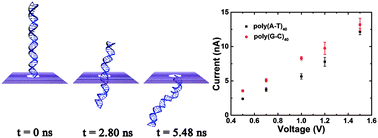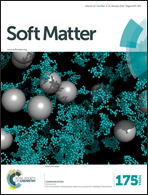DNA translocation through single-layer boron nitride nanopores†
Abstract
Ultra-thin nanopores have become promising biological sensors because of their outstanding signal-to-noise ratio and spatial resolution. Here, we show that boron nitride (BN), which is a new two-dimensional (2D) material similar to graphene, could be utilized for making a nanopore with an atomic thickness. Using an all-atom molecular dynamics simulation, we investigated the dynamics of DNA translocation through the BN nanopore. The results of our simulations demonstrated that it is possible to detect different double-stranded DNA (dsDNA) sequences from the recording of ionic currents through the pore during the DNA translocation. Surprisingly, opposite to results for a graphene nanopore, we found the calculated blockage current for poly(A–T)40 in a BN nanopore to be less than that for poly(G–C)40. Also in contrast with the case of graphene nanopores, dsDNA models moved smoothly and in an unimpeded manner through the BN nanopores in the simulations, suggesting a potential advantage for using BN nanopores to design stall-free sequencing devices. BN nanopores, which display several properties (such as being hydrophilic and non-metallic) that are superior to those of graphene, are thus expected to find applications in the next generation of high-speed and low-cost biological sensors.


 Please wait while we load your content...
Please wait while we load your content...